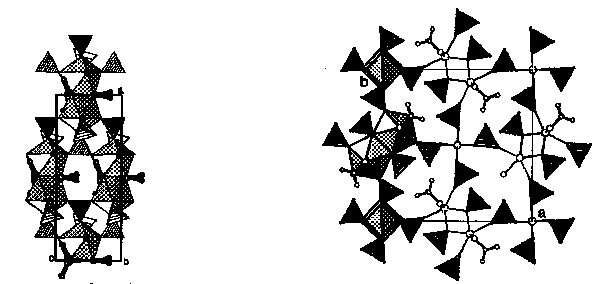
CAN SMALL ORGANIC MOLECULES INTRODUCE NONLINEARITY INTO AN INORGANIC MATRIX?--By Olyana Angelova, CL of Mineralogy and Crystallography, BAS, Rakovski 92, 1000 Sofia, Bulgaria
New addition compounds with potential nonlinear optical properties in the ternary systems M(ReO4)2-L-H2O, where M =Ca, Sr, Ba, Pb, Cd; L = urea (U), thiourea (Tu) or similar polarizable organic molecules have been prepared and structurally characterized. Among the variety of centrosymmetric adducts of the general type xM(ReO4)2.yL.zH2O investigated so far the only noncentrosymmetric species are those with partial content of L, e. g. 2M(ReO4)2.3U.2H2O (I), M = Sr, Pb, and 3Pb(ReO4)2.2Tu.2H2O (II).
I crystallizes as a layered structure of the type [M2T4f3]f'2 2, T = ReO4, f = Urea, f' = H2O (space group Fdd2) and contains specific triple M-O-M bridges imposing stable departure from centrosymmetricity.
The framework structure of II (P 421m) consists of two types of chains running along the c-axis: [MT4] and [M2T2f2]f'2, f = Tu, f' = H2O. The Tu molecules are built within the pseudo-centrosymmetric [M2T2f2]f'2 chains but are H-bonded to the non-centrosymmetric [MT4] ones.
In both compounds the amount of organic molecules is unsufficient for achievement of centrosymmetric arrangement of the structural units but enough to perturbate the antiferroelectric ionic structure. The immanent polarizability of the organic molecule can be the key factor to obtain a large permanent crystal polarization if it is favoured by its orientation within the inorganic matrix.

see original abst. for text wrap when you place on page maker